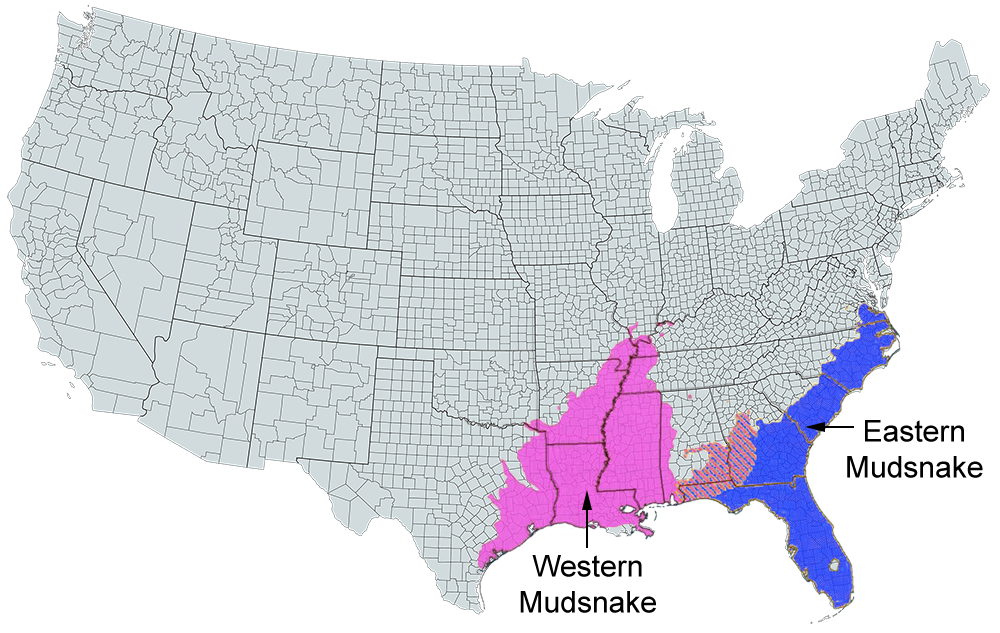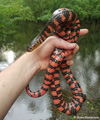Eastern Mud Snake
Farancia abacura abacura
** Harmless **
Common Name: |
Eastern Mudsnake |
Scientific Name: |
Farancia abacura abacura |
Etymology: |
|
Genus: |
Farancia has no know meaning. |
Species: |
abacura is derived from the Latin word abacus which means "counting board". |
Subspecies: |
abacura is derived from the Latin word abacus which means "counting board". |
Vernacular Names: |
Checkered snake, dart snake, eastern horn snake, hoop snake, North American red-bellied snake, stinging snake, thunder snake. |
Average Length: |
40 - 54 in. (102 - 137 cm) |
Virginia Record Length: |
58.6 in. (148.9 cm) |
Record length: |
85.1 in. (207 cm) |
Systematics: John Edwards Holbrook, the father of North American herpetology, originally described this species as Coluber abacurus in 1836, based on a female collected in South Carolina (ANSP 5146); the collector and exact date are unknown. Schmidt (1953) restricted the type locality to Charleston, South Carolina. Baird and Girard (1853) first used the genus Farancia for this species. All authors in the Virginia literature have followed this nomenclature. Two subspecies are recognized: F. a. abacura (Holbrook) and F. a. reinwardtii Schlegel. McDaniel and Karges (1983) and Conant and Collins (1991) illustrated the geographic ranges of these forms. Only the nominate subspecies occurs in Virginia.
Description: A large, robust snake reaching a maximum total length of 2,070 mm (81.5 inches) (Conant and Collins, 1991). In Virginia, maximum known snout-vent length (SVL) is 1,350 mm (53.1 in.) and total length is 1,489 mm (58.6 in.). In the present study tail length/total length averaged 13.6 ± 3.4% (7.2-17.9, n = 18).
Scutellation: Ventrals 169-199 (ave. = 184.9 ± 10.1, n = 19); subcaudals 31-51 (ave. 40.6 ± 6.0, n = 19); ventrals + subcaudals 200-237 (ave. = 225.5 ± 8.3, n = 19); dorsal scales smooth, scale rows 19 (100%, n = 16) at midbody, scales above tail weakly keeled; anal plate divided; infralabials 8/8 (26.7%, n = 15), 8/9 (33.3%), or 9/9 (33.3%), although one abnormal specimen with 6/8 (6.7%); supralabials 7/7 (82.4%, n = 17) or combinations of 7-8 (17.6%); 1 internasal; loreal present, twice as long as wide; no preoculars; postoculars 2/2; temporals usually 1+2/1+2 (83.3%, n = 18) or other combinations of 1-3 (16.7%).
Coloration and Pattern: Dorsum shiny black; dorsal head scales black, variously outlined in cream; venter red to pink; ventral coloration extends upward onto lateral portion of body and dorsal black pigmentation extends onto venter, giving appearance of alternating red and black lateral blotches or bars; chin, labial scales, and throat yellow; venter of neck red; black spots on lower sides of neck; a row of black spots occurs on infralabials and supralabials. This is a stout-bodied snake with a somewhat flattened head and a keratinized point on the tip of the tail.
Sexual Dimorphism: There is no sexual dimorphism in pattern and color in this species. Adult females were larger (ave. SVL = 1,097.7 ± 164.8 mm, 863-1,350, n = 7) than males (ave. SVL = 900.9 ± 159.8 mm, 725-1,106, n = 8). Sexual dimorphism index was 0.22. Females had relatively shorter tails (tail length/total length: female ave. = 10.3 ± 2.0%, 7.2-13.0, n = 8; male ave. = 16.4 ± 0.9%, 15.2-17.9, n = 10). Males averaged fewer ventral scales (177.9 ± 6.6,169-195, n = 11) than females (ave. = 194.5 ± 4.4, 185-199, n = 8), but more subcaudals (male ave. = 44.4 ± 5.0, 31- 51, n = 11; female ave. = 35.5 ± 2.2, 31-39, n = 8). Ventrals + subcaudals averaged higher in females (ave. = 230.0 ± 5.1, 220-235, n = 8) than males (ave. = 222.3 ± 8.9, 200-237, n = 11).
Juveniles Juvenile F. abacura are colored and patterned as adults. They were 180-260 mm SVL at hatching in Florida and Louisiana (Goldstein, 1941; Tinkle, 1959). Hatching size is unknown in Virginia.
Confusing Species: This species may be confused with Coluber constrictor and Pantherophis alleghaniensis because of the black dorsum. These two species lack the red venter, the lateral alternating red and black coloration, the yellow chin, and black spots in the labial scales. Nerodia sipedon may also be nearly black with reddish markings laterally, but this species has strongly keeled scales and crossbands and blotches on the dorsum. Rainbow snakes, Farancia erytrogramma, sometimes found in the same habitats, are morphologically similar but have longitudinal red and black stripes.
Geographic Variation: There are too few specimens available to determine if patterns of geographic variation exist in the Virginia range of this species. Mount (1975) noted that in Alabama the average numbers of ventrals and subcaudals in males were 166.3 and 45.0 and in females were 191.4 and 37.2, respectively. Duellman and Schwartz (1958) found average counts of 174.3 ventrals and 47.0 subcaudals for males, and 195.0 ventrals and 36.2 subcaudals for females in north-central Florida. The number of ventrals for Virginia specimens was more similar to the Florida samples than the Alabama samples, whereas the subcaudal counts were roughly similar in all three areas.
Biology: Almost nothing is known of the biology of F. abacura in Virginia. Of the specimens available, most were killed on roads that traversed swamp habitat. It is a secretive, burrowing snake that spends most of its life associated with lotic water. Habitats include slow-moving streams and canals, swamps, forested wetlands, sluggish mud-bottom creeks, and ponds and lakes with swampy margins and aquatic vegetation (Wright and Wright, 1957; Mount, 1975). It may enter brackish water (Ernst and Barbour, 1989b). Eastern Mud Snakes are nocturnal and may move overland during warm and humid or rainy periods. They may also be found occasionally during the day on banks under vegetation cover. All but one of the Virginia captures were made between 25 May and 3 August; one adult female was found on 27 January. These snakes apparently overwinter buried in soil on land or in decaying pine stumps (Neill, 1948a).
Farancia abacura eats aquatic amphibians, including Amphiumas (Amphiuma means), Greater Sirens (Siren lacertina), earthworms, tadpoles, small salamanders, and some frogs and fish (Wright and Wright, 1957). Enlarged teeth occur at the rear of the upper jaw, which presumably aid in holding slippery prey. Upon being disturbed, mud snakes will sometimes tuck their head beneath their coils and expose the red venter on the tail, thus using it as a warning display (Ernst and Barbour, 1989b).
Throughout its range, F. abacura deposited 4-104 (ave. =32.2) eggs in a single nest cavity (Fitch, 1970). Females excavate a chamber in moist soil, usually under a log or in a mound above water level. They remain with the eggs until hatching, presumably to protect them against predators. One female was found in Seashore State Park tending about 10 eggs beneath a moist log in early September (C. A. Pague, pers. comm.). Eggs (30-35 x 19.5-25 mm) and newly hatched juveniles (180-234 mm total length) have been found July through October (Ernst and Barbour, 1989b). In South Carolina, young-of-the-year juveniles (180-260 mm SVL, ave. = 223 ± 19.5) entered aquatic habitats March-May and September-October (Semlitsch et al., 1988).
The population ecology of this species has not been studied.
Remarks: Other common names in Virginia are barred mud snake (Dunn, 1936); red-bellied snake and stinger snake (Carroll, 1950); and horn snake, hoop snake, and red-bellied swamp snake (Linzey and Clifford, 1981). Brothers (1992) additionally listed stinging snake, hook snake, and barrel hooper for the Dismal Swamp region.
Farancia abacura is thought to be the species featured in hoop snake stories. This snake is said to travel by taking its tail in its mouth and rolling down a hill chasing after someone. When it reaches the bottom, it releases its tail and launches itself into the air, seeking to imbed the stinger of the tail in the person; the wound is always fatal. If the snake misses and strikes a tree, the tree will wither and die. In one story mentioned by Beck (1952), the snake's stinger struck the handle of a pick-axe causing it to swell and burst the iron pick. Mud snakes do have a pointed, hardened tail tip but presumably use it only for prodding prey into position for eating. They cannot form a hoop and roll across the ground. The tip of the tail will prod humans in various places while the snake is being held.
Conservation and Management: The status of the Eastern Mud Snake in Virginia is unknown. Continued loss of freshwater wetlands is undoubtedly causing the loss of some populations. Swamps and backwaters of Coastal Plain rivers and streams should be protected from encroachment and pollution, especially siltation and chemicals that kill aquatic amphibians. The surrounding terrestrial landscape should be maintained in a natural state, as these and other animals use this habitat for overwintering and nesting.
References for Life History
Photos:
*Click on a thumbnail for a larger version.
Verified County/City Occurrence in Virginia
Amelia
Charles City
Greensville
Isle of Wight
New Kent
Prince George
Southampton
Surry
Sussex
CITIES
Chesapeake
Suffolk
Virginia Beach
Verified in 9 counties and 3 cities.
U.S. Range

US range map based on work done by The Center for North American Herpetology (cnah.org) and Travis W. Taggart.








